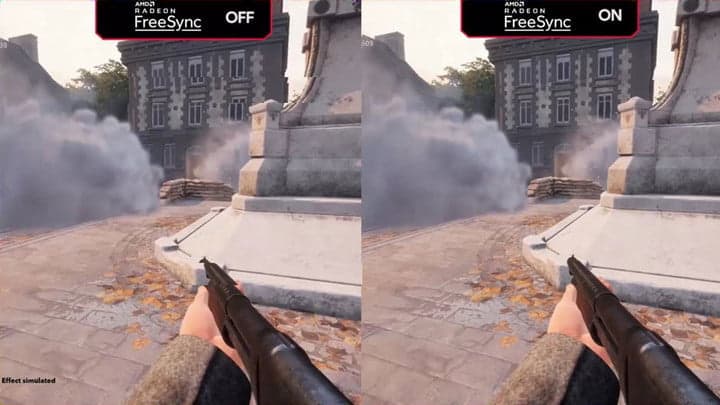A contemporary graphics card includes numerous features designed to enhance your user experience. AMD has now released its FreeSync technology, which is key for ensuring seamless gameplay.
To better understand what FreeSync actually is, we first need to know about the problem it addresses.
Table of ContentsShow
Screen Tearing

This problem is a superb illustration of how a lack of synchronization during technological advancement doesn’t always flourish.
During the mid-to-late 2000s, the abilities of GPUs expanded swiftly, which caused a domino effect in the PC world.
Game graphics evolved from the 8-bit style of the 80s (which was by necessity more than choice) to nearly realistic visuals starting with the seventh generation of video game consoles. With each fresh generation of consoles, there was a significant jump in graphical quality.
Unlike the clearly defined evolution of consoles, the progression of PC technology was continuous, and people pushed their machines to the limit. This is where things rapidly came to a head.
The leading GPUs of the period rushed to evolve to a level where they could produce excellent images at an ever-faster rate. The development of display technology was unable to keep up.
Screen Tearing
At the time, 60Hz monitors were becoming the standard, creating an issue where a GPU could send images at a faster rate than the monitor could display. This resulted in a scenario where a monitor would try to display two images at the same time, which caused an effect known as screen tearing.
This was a “blink, and you’ll miss it” kind of problem, but it was still sufficient to be disruptive and ruin many gamers’ enjoyment.
What happened is that part of the screen would display one frame while another showed the next frame. The poor synchronization between the monitor and the GPU made the image appear as though it was cut in half.

One of the prominent solutions for the issue of screen tearing is AMD’s FreeSync.
What Is FreeSync?

FreeSync is a ideal solution to screen tearing. It is a component added to the monitor itself, as well as the GPU, which establishes communication between the two and synchronizes them.
This means that if a GPU produces 100 frames per second, FreeSync will tell the monitor to raise or lower its refresh rate to be identical with the GPU. As the GPU’s framerate fluctuates, FreeSync continually adjusts the display’s refresh rate to synchronize the two devices.
FreeSync isn’t the initial technology to achieve this.
AMD’s chief competitor, NVIDIA, released its own solution about two years earlier, called G-Sync. This tech works the same way as FreeSync but with one vital distinction: it isn’t free.
NVIDIA requires monitor manufacturers to purchase a license to use G-Sync technology solely on their displays, which in turn made monitor companies increase their economic burdens.
Fortunately, things are now moving in a more favorable direction. More and more monitors are able to use both G-Sync and FreeSync, allowing you to switch your GPU without worrying whether or not you will still be able to enjoy proper vertical synchronization.
There were previous attempts to fix the screen tearing problem, with perhaps the most significant being VSync. Unlike FreeSync or G-Sync, VSync is a software-only solution and can only limit the GPU, as it can’t communicate with the monitor.
Although this isn’t the ideal solution, it’s still somewhat functional.
Is FreeSync Worth It?

The answer to this question isn’t as straightforward as you might have expected from some of our previous points. As hinted at earlier, getting a FreeSync monitor means that you’ll almost entirely have to game with an AMD graphics card.
Luckily, AMD is no longer as far behind NVIDIA as it used to be in terms of performance, so this isn’t a major tradeoff. With the way monitors are adapting to use both technologies, this might not be an issue at all in the forthcoming few years.
However, that is in the future, and currently, in 2022, FreeSync’s importance to you largely depends on the graphics card you plan on using.
It is suggested that you use an AMD graphics card (RX 6000 series) if you’re looking to play the latest games on your FreeSync monitor.
There are two other options crucial to mention. FreeSync Premium and FreeSync Premium Pro are two additional versions of FreeSync and are relatively new to the market.

Despite their names, there are no additional costs involved with these two. However, there is an issue of availability, as you’ll need to own a relatively current monitor model to play games using them.
The negative is that only certain AAA games have embraced these technologies, so you might not be able to enjoy them to their complete extent just yet.
Both options have minimal framerate adjustment, which will help the monitor adapt if the GPU falls below its reduced threshold by setting the refresh rate to multiple FPS.
FreeSync Premium Pro is also much better suited for high dynamic range imaging (or HDR), which is intended to produce even enhanced quality pictures when using ray tracing (which AMD’s newest cards are).




